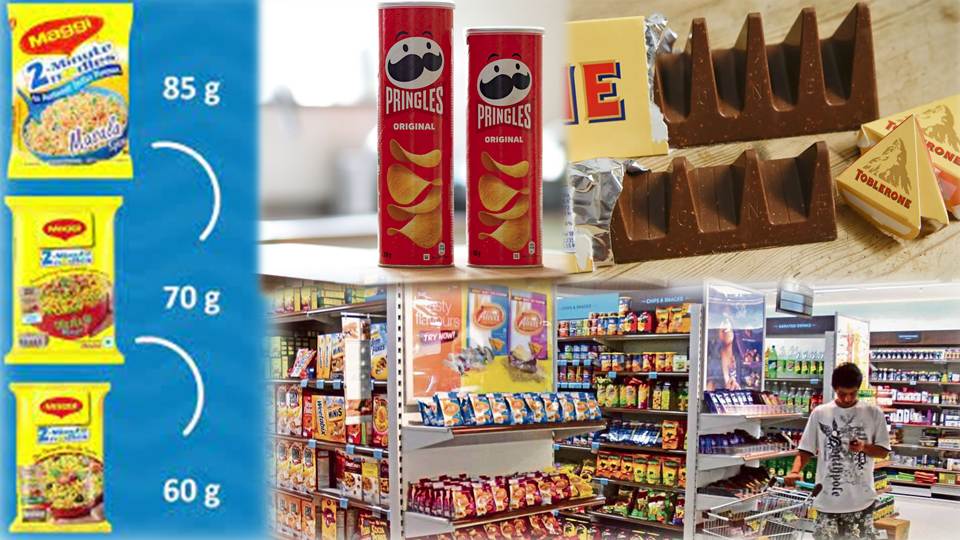“Wall Street loves to use confusing terms to make you think only they can do what they do.” It is a scintillating sarcasm on the dark shades of the financial world. The financial world relies on verbal jugglery to ensure that consumers do not notice their financial ones. Shrinkflation is also one of such terms.
What is Shrinkflation?
Shrinkflation is the combination of two words. Shrink and Inflation. The shrink in Shrinkflation means reduction in the size and quantity of the product, while the flation is used to describe inflation.
As the meaning of this two terms suggest, shrinkflation is a tactic mainly used when consumers’ purchasing power starts to shrink due to increase in inflation.
Shrinkflation is defined as reducing the size of the product while maintaining its sticker price. Sometimes companies also engage in reforming or reducing the quality of the product within the regulatory parameters.
But why do companies do this?
There are a plethora of reasons behind it, but the main reason is increasing inflation. Increase in inflation means that the consumers are not able to buy the same quantity of products for the same price.
For instance, estimates indicate that if you could buy something for $1 in 1900, you will have to spend at least $35.26 in 2022 to buy the same quantity of that product.
Why does it happen? Because, companies also have to spend extra on capital expenditure and transportation costs. Continuous increase in the price of raw materials to companies makes it next to impossible for them to keep the input cost as low as they used to afford in the past.
But, the problem is in order to increase their operating margin; they have to maintain the sales volume. So, they resort to downsizing
But don’t they have other options?
Yes, they have. In fact, commonsensical wisdom suggests that they should start increasing the price of the product. Ideally, this should have been the way forward, but there is a problem. It hurts the perception around the product.
Academic researches have shown that consumers are less likely to trust a company which engages in increasing the price of the same product. On contrary, people’s perception about the company did not change drastically due to downsizing of the product.
Companies are aware of how people’s minds are sensitive towards their pockets. This is why they do not engage in drastic change in size. The change in quantity generally does not cross more than 20 per cent of the previous one.
Moreover, a lot of times, these companies create an optical illusion by decreasing the quantity of the product but keeping the packet size of the same length. Companies selling Chips packets are prime examples of it.
Are consumers so naive?
No, they are not. But the thing is that they are too busy to notice it. People in Tier-II and Tier-III cities are not much keen on highlighting these issues. On the other hand, people in Tier-I cities mainly consume food products for taste and a 20 per cent of change in quantity is penny for them.
In the case of non-food products like toilet paper, the packet takes a lot of time to consume, by which they just forget what was the quantity requirement from the final product.
Moreover, the companies also use virtue signalling tactics to sell their products. Companies have been found to brand their products as “less is more” or “less is healthier”. A lot many times, they also tell consumers that by consuming less, they are contributing greenery to the environment. Even packaging is sold as a breakthrough.
Can you name some companies doing it?
Yes, lot of companies are doing it in India as well as abroad. These include not just with low ticket size, but also those which have extremely good reputation.
Hindustan Unilever has reduced the weight of its Rs10 Vim Bar from 155gms to 135 gms. Similarly, Haldiram has reduced the quantity of Aloo Bhujia from 55gms to 42gms. Dabur, Cadbury, Procter & Gamble are some of the other famous companies which have adopted this strategy.
Lot of these companies (mainly in the FMCG segment) are also resorting to launching ‘Bridge Packs’. Bridge packs are the packs lying between established price range. The reason behind launching these packs is that to an extent, companies can’t reduce the quantity of the product that being sold at a fixed price, otherwise consumers will just stop buying from them.
So, to increase their per gram profit, they launch a pack whose cost lies between the attractive price range (Rs 12 for a price range of Rs 5- Rs 10). So, if for Rs 5, they are selling 50 gm of product (10gm per Rupee), Rs 12 pack will contain only 100gm of the product (8.33gm per Rupee).
Is there a way out?
There are only two ways. Either the government could correct it or the people should be aware about it. To be fair, it would hamper the long term economic perspective of a country, if the government interferes too much in the business strategies of the Companies.
Despite that risk, the U.K. government is doing it, while most other countries rely on alarming consumers through official broadcast channels.
At the end of the day, it all comes down to consumers. They need to chalk out an extra few seconds in order to ensure that companies do not go haywire. Companies do not have emotions, they only listen to market sentiments and people are inalienable part of market.
Support TFI:
Support us to strengthen the ‘Right’ ideology of cultural nationalism by purchasing the best quality garments from TFI-STORE.COM.
